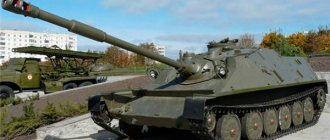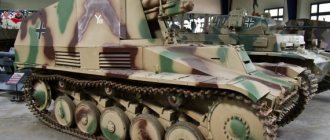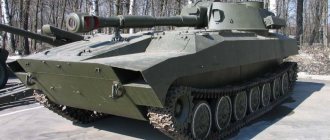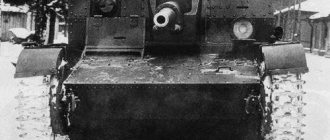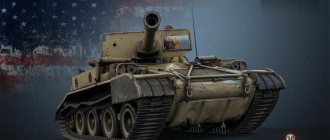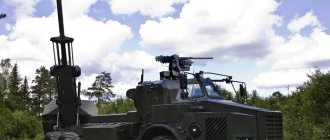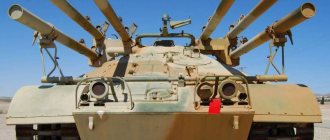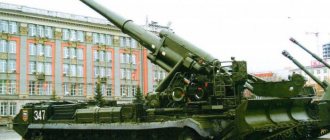Airborne self-propelled gun ASU-57. Armament. TTX. Dimensions. Weight. Booking
A light airborne artillery mount of the anti-tank self-propelled gun class was developed in the late 40s. specifically for arming airborne troops. And in 1951, the installation was accepted for service and was mass-produced until 1962. ASU-57, a semi-closed installation with a front-mounted MTO, had a fighting compartment, combined with a control compartment, and located in the rear of the hull. It housed a crew of three people and a gun. The bulletproof armor protection of the hull was made of steel and aluminum armor plates, which were welded together.
Self-propelled gun ASU-57 - video
By using aluminum alloys in the design, the designers achieved a reduction in the size of the machine, as well as a reduction in its weight. The bow was made of two armor plates welded together and with the sides of the hull. The front part of the bottom was attached to the bottom sheet. The sides of the hull consisted of vertical armor plates, which were welded to the suspension niches and sides, as well as to the front shields. The bottom of the hull and the stern were protected by duralumin sheets. For the convenience of the crew, the upper parts of the front and side sheets were made folding.
The chassis of the vehicle included three rubberized track rollers, a rubberized tension wheel, which was also a support wheel, with a built-in screw-type tension mechanism, two support rollers and sprockets on each side, having two ring gears with an asymmetrical tooth profile. The vehicle gained high mobility and cross-country ability thanks to its tracked propulsion system. The car's suspension was a tubular-rod torsion bar with hydraulic shock absorbers on the front units. The metal fine-link caterpillar chain, 204 mm wide, consisted of 80 tracks.
The vehicle could immediately overcome a ditch or trench up to 1.4 m wide and a vertical obstacle up to 0.5 m high. The maximum elevation angle reached 30°. The ASU-57 could also overcome water obstacles, but only ford, since it was not equipped with floating equipment. The depth of the fords to be overcome should not exceed 0.7 m. The specific pressure of the vehicle on the ground was only 0.35 kg/cm2, which is equal to the pressure on the ground of an adult. The installation was transported using heavy Yak-14 and Il-32 gliders, and to avoid the hull swinging at this moment, the vehicle had a special device that fixed the outer suspension units to the hull.
The carburetor 4-cylinder liquid-cooled engine M-20E was located across the body in a block with a gearbox and onboard clutches with band brakes. The entire block rested on four elastic supports and was secured with only four bolts, which ensured its easy and quick replacement if necessary. At the front of the case there were water and oil radiators, as well as a fan with a drive.
The ASU-57 self-propelled gun had powerful weapons. A long-barreled 57-mm 4-51 cannon was installed in the conning tower. Here, batteries, part of the ammunition and spare parts were placed on the fender shelves. The gun was equipped with a two-chamber muzzle brake and an ejector. It had a vertical wedge shutter with semi-automatic mechanical type and a trough-shaped cradle mounted on a frame. Firing from closed positions was carried out using an artillery panorama. When firing direct fire, an OP2-50 optical sight with illumination was used at night and in poor visibility. The gun's ammunition included 30 unitary, or shells connected to a cartridge case, of three types: sub-caliber armor-piercing, cumulative and fragmentation grenades. The rate of fire was 6-10 rounds per minute.
Since 1955, the ASU-57 began to be equipped with a new modernized Ch-51M gun with a slot brake, in which the bolt was opened and the cartridges were drawn out at the end of the roll; the rotating mechanism was equipped with a braking device. The ASU-57 was equipped with a TPU-47 tank intercom for three subscribers, a 10-RT-12 radio station located in the fighting compartment and providing communication at a distance of up to 20 km, and a night vision device.
Two more vehicles were created on the basis of the ASU-57. ASU-57P is a floating airborne self-propelled artillery unit. The car appeared in 1954. Its power transmission included a power take-off with a drive to the propeller located in the bottom niche. First, the designers equipped the machine with two propellers driven by guide wheels. This provided remarkable maneuverability on the water, but the tracks did not turn off; when going ashore, the engine worked in low gears, so it lacked traction. More successful was the option already tested on the light pre-war T-40 tank, where the propeller and rudder were located in a tunnel. The cooling system was additionally equipped with a heat exchanger, which ensures that when moving afloat, heat is removed from the coolant into the sea water leaving the propeller.
In addition, the ASU-57P was equipped with the Ch-51P cannon, an improved version of the Ch-51M, in which the tube was connected to a more technologically advanced active muzzle brake, breech design, semi-automatic mechanism and lifting device. This improved version of the ASU-57P was never put into service. Not the least role in this was played by rather weak security, meeting the needs of the armed forces for this type of vehicles at the expense of the already mass-produced ASU-57, as well as the appearance by that time of the already more powerful SU-85 vehicle.
The ASU-57 KShM was parachuted using a Yak-14 glider and for several years was the only self-propelled gun in the world dropped by parachute.
Performance characteristics of ASU-57
— Layout diagram: engine-transmission compartment at the front, combined control and combat compartment at the rear — Manufacturer: MMZ — Years of development: 1948—1950 — Years of production: 1950—1962
Crew: 3 people
Weight of ASU-57
— Combat weight, t: 3.35
Overall dimensions of ASU-57
— Hull length, mm: 3480 — Length with gun forward, mm: 5750 — Width, mm: 2086 — Height, mm: 1460 (on the awning), 1180 (with lowered flaps) — Ground clearance, mm: 300
Reservation of ASU-57
— Armor type: rolled homogeneous steel — Hull forehead (top), mm/deg.: 6/65° — Hull forehead (middle), mm/deg.: 6/20° — Hull forehead (bottom), mm/deg. : 6 — Hull side, mm/deg.: 4 / 0° — Hull rear, mm/deg.: 6 (non-armored duralumin) — Bottom, mm: non-armored duralumin — Conning front, mm/deg.: 6 / 36° — Cabin side, mm/deg.: 4 / 15° — Cabin stern, mm/deg.: open — Cabin roof, mm/deg.: open
Armament ASU-57
— Caliber and brand of gun: 57-mm Ch-51 — Type of gun: rifled semi-automatic — Barrel length, caliber: 74.16 — Gun ammunition: 30
— Angles VN, degrees: −5…+12 — Angles GN, degrees: ±8 — Sights: periscope OP2-50, panoramic periscope sight MP-50
— Machine guns: 1 × 7.62 mm SG-43 or SGM
Engine ASU-57
— Engine type: M-20E — Engine power, l. p.: 55
Speed ASU-57
— Highway speed, km/h: 45 — Cross-country speed, km/h: 20–25
— Cruising range on the highway, km: 250 — Specific power, l. s./t: 16.4 — Suspension type: individual torsion bar, with hydraulic shock absorbers — Specific ground pressure, kg/cm²: 0.35
— Overcome ascent, degrees: 30 — Overcome wall, m: 0.5 — Overcome ditch, m: 1.4 — Overcome ford, m: 0.7
Links[edit]
- "ASU-57". Tank Encyclopedia
. Retrieved November 11, 2022.
- Call, Christian (2009). Soviet Cannon: A Comprehensive Study of Soviet Weapons and Ammunition in Calibers from 12.7mm to 57mm. Austria: Coll. item 491. ISBN. 978-3-200-01445-9.
- Bail Stephen J.; Hull Andrew J.; Markov David R. (1999). Soviet/Russian armored vehicle and artillery design methods: 1945 to the present
. Darlington Productions. pp. 288–291. ISBN 1-892848-01-5. - Solyankin, AG; Zheltov I.G.; Kudryashov, K.N. (2010). Domestic Armored Vehicles - XX century, Volume 3: 1946-1965
. LLC "Tseykhgauz" pp. 530–533. ISBN 978-5-9771-0106-6.
Photo of self-propelled gun ASU-57
Self-propelled guns ASU-57 in Czechoslovakia. 1968
Self-propelled gun ASU-57 on the parachute platform PP-127-3500
Similar
SAU 2S7 Pion (2S7M Malka) performance characteristics. Caliber. Dimensions. Firing range
MLRS BM-21 Grad. Damage area. Rockets. Caliber. Story
120-mm mortar 2B11 complex 2S12 Sani TTX. Firing range. Weight
Mortar 2B9M Vasilek 82 mm Rate of fire. Firing range. Weight
Self-propelled gun 2S3 Akatsiya 152 mm. Firing range. Dimensions. Weight. Engine
SAU 2S1 Gvozdika 122 mm Firing range. Dimensions. Device. Weight
Gun 2A36 Giatsint-B 152 mm. Firing range. Dimensions. Device
MLRS 9K58 Smerch Damage area. Rockets. Caliber. Story
MT-12 Rapier gun. Firing range. Story. Dimensions
Howitzer D-30 122-mm performance characteristics. Firing range. Dimensions. Weight
2S4 Tulip self-propelled mortar 240 mm performance characteristics. Dimensions. Firing range. Weight
Self-propelled gun 2S35 Koalitsiya-SV 152-mm performance characteristics. Firing range. Dimensions. Weight
Howitzer Msta-B (2A65) 152 mm. Firing range. Dimensions. Weight. Ammunition
Self-propelled gun 2S9 Nona-S 120 mm performance characteristics. Firing range. Dimensions. Weight. Armament
AT-T heavy artillery tractor. TTX. Dimensions. Engine. Story
SAU 2S19 Msta-S 152 mm Dimensions. Speed. Engine. Story
MLRS 9K57 Hurricane Damage area. Rockets. Caliber. Story
TOS-1 Buratino (TOS-1A Solntsepek) performance characteristics. Damage area
Divisional gun ZIS-3 76 mm. TTX. Firing range. Dimensions. Weight
Howitzer gun D-20 152 mm performance characteristics. Firing range. Dimensions. Weight
Howitzer M-30 model 1938 122-mm performance characteristics. Firing range. Dimensions. Weight
Self-propelled gun 2S5 Giatsint-S 152 mm performance characteristics. Firing range. Armament. Dimensions. Weight
Self-propelled gun Ferdinand (Elephant) performance characteristics. Reservation. Weight. Dimensions
Self-propelled gun SU-100. TTX. Armament. Dimensions. Shells. Weight. Speed
Self-propelled gun Sturmtiger caliber 380 mm. TTX. Armament. Shells. Reservation. Dimensions
203-mm howitzer B-4 model 1931 performance characteristics. Weight. Ammunition. Dimensions
Self-propelled gun SU-152 St. John's wort 152 mm performance characteristics. Shells. Firing range. Dimensions. Weight
Gun M-46 130-mm performance characteristics. Firing range. Dimensions. Weight
Demining installation UR-77 Meteorite TTX. Armament. Dimensions
MLRS 9K51M Tornado-G. Rockets. TTX. Firing range. Dimensions
SAU 2S31 Vienna 120 mm. Firing range. Story. Dimensions. Weight
German self-propelled gun StuG III. Modifications. Dimensions. Armament. Weight
Guided projectile Krasnopol. TTX. Firing range. Dimensions. Price
Mortar Karl 600 mm and 540 mm performance characteristics. Firing range. Weight. Dimensions
Big Bertha 420 mm gun. TTX. Weight. Dimensions. Ammunition
Self-propelled gun SU-76. TTX. Dimensions. Reservation. Weight. Story
SAU 2S23 Nona-SVK 120-mm performance characteristics. Armament. Range and accuracy of fire. Dimensions
SAU 2A3 Condenser-2P caliber 406 mm Firing range. Armament. Dimensions. Weight
Mortar M-160 caliber 160-mm performance characteristics. Firing range. Ammunition. Dimensions
Airborne self-propelled gun ASU-57. Armament. TTX. Dimensions. Weight. Booking
Artillery complex A-222 Bereg 130 mm. TTX. Firing range. Ammunition
Howitzer BR-18 caliber 305 mm TTX. Firing range. Weight
152 mm howitzer D-1. Firing range. Dimensions. Weight. Device
Mortar M-240 caliber 240 mm. Firing range. Dimensions. Weight
Self-propelled gun SU-85. Ammunition. Reservation. Dimensions. Weight. Engine
Counter-battery radar Zoo-1 (1L219M). Range of control of firing positions. Device
SAU 2S25 Sprut-SD. Caliber. Story. Dimensions. Weight. Engine
Self-propelled gun 2S34 Hosta 120 mm. TTX. Dimensions. Firing range. Armament. Weight
Self-propelled gun ASU-85. Armament. Dimensions. Reservation. Weight
280-mm mortar Br-5 model 1939 Dimensions. Weight. Ammunition
Self-propelled gun 2A45M Sprut-B. TTX. Speed. Engine. Weight
Belarusian MLRS BelGrad. TTX. Firing range. Ammunition. Dimensions
S-23 cannon 180 mm caliber. Ammunition. Weight. Dimensions. Firing range
Self-propelled gun SAU SU-122. Dimensions. Armament. Reservation. Weight
Self-propelled gun Jagdpanther. Weight. Reservation. Dimensions. Armament
Multi-barreled self-propelled gun M50 Ontos. TTX. Armament. Dimensions. Booking
D-74 cannon 122 mm caliber. Firing range. Dimensions. Weight
Artillery tractor T-20 Komsomolets. Armament. Reservation. Dimensions. Weight
Artillery tractor YA-12. Dimensions. Weight. Load capacity. Engine
SAU ISU-122. Armament. Dimensions. Weight. Booking
RPU-14 (8U38) - rocket launcher
2K32 Deva - 82-mm self-propelled mortar system
MLRS BM-24 (T) 240 mm. Firing range. Dimensions. Weight. Engine
Artillery tractor Comintern. Load capacity. Dimensions. Weight. Engine
Self-propelled gun SU-122-54. Reservation. Dimensions. Weight. Firing range
MLRS BM-14-16. Armament. Dimensions. Weight. Firing range
Self-propelled gun Nashorn (Rhinoceros). Armament. Dimensions. Weight. Booking
BR-2 gun caliber 152 mm. Firing range. Dimensions. Weight
Self-propelled howitzer self-propelled gun PzH 2000. Firing range. Dimensions. Weight
BR-17 cannon 210 mm caliber. Weight. Firing range. Rate of fire
Self-propelled gun Vespe 105 mm. Armament. Dimensions. Reservation. Weight
Wheeled self-propelled gun GAZ-68 (KSP-76). Armament. Dimensions. Weight. Engine
Self-propelled gun Brummbar 150 mm. Armament. Dimensions. Weight. Booking
Heavy self-propelled gun SU-14. Reservation. Dimensions. Weight. Engine
Self-propelled gun SU-5. Armament. Reservation. Dimensions. Weight
Self-propelled gun AT-1. Reservation. Dimensions. Weight. Engine
Self-propelled gun SU-12. Armament. Reservation. Dimensions. Weight
Operators[edit]
Map of former ASU-57 operators in red
Former operators[edit]
Egypt
- The Egyptian Army received small numbers of ASU-57s in the early 1960s; they were used during the 1967 Six Day War.
Ethiopia
- During the Ogaden War of 1977, the Ethiopian army received several dozen self-propelled guns.
East Germany
- In 1961–1962, Nationale Volksarmee
received 20 ex-Soviet army vehicles.
North Korea
- The Korean People's Army ground forces ordered 200 vehicles in 1966. All of them were previously used by the Soviet Army and were delivered in 1967 and 1968.
Sahara Republic
- The Polisario Front received an unknown number of vehicles from Libya.
Soviet Union
- The Soviet Army used the ASU-57 as part of the VDV Airborne Forces.
Vietnam
- Vietnam People's Army
Yugoslavia
- Yugoslav People's Army
